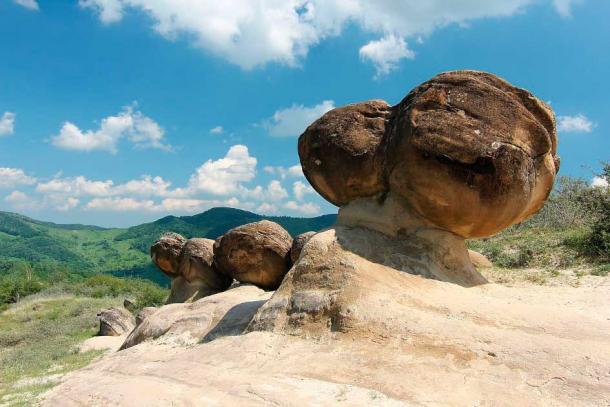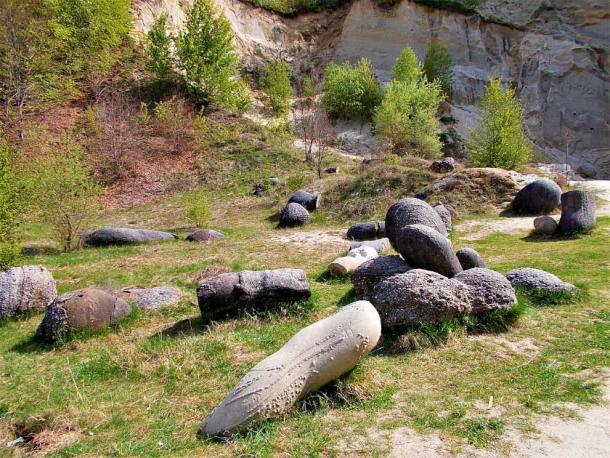
Romania’s Enigmatic Trovants: Living Rocks That Grow and Move!
Roughly six million years ago, paleo-earthquakes created a type of geological phenomenon called trovants. They are also known as the stones of Costesti, after their most famous location in Romania, or the “living stones.” Romania’s rare trovants were formed under highly complex circumstances involving seismic shifts, sand sediment in rivers and rain, and lots of time. And the locals of Costesti, Romania consider them to be alive! Having witnessed them grow, expand, and move over generations the Romanians have turned the trovants into local legends and myths. For geologists, trovants have long been a captivating mystery.
What are Trovants?
Trovants are made up of a hard stone center surrounded by sandstone and vary in size from extremely small and pebble-like trovants to stones weighing several tons. Although most trovants are made from sandstone originally, geologists have also found some made from gravel or gritstone. Trovants are an incredibly exciting and unique type of rock formation found within specific areas of Romania.
How are Trovants Formed?
The name trovant is a synonym from the German word “ Sandsteinkonkretionen” meaning “cemented sand,” which explains how these rocks are made. Trovants can only be formed when sand accrues with sandstone deposits around a hard stone core and is cemented by water that has a high concentration of calcium carbonate. This mixture melds together to make these truly fascinating rocks known by locals as the “growing stones.”
- Hidden Romanian Treasures– A Cursed History
- Huge Bronze Age Citadel, Three Times Larger than Troy, Found in Romania
What makes them so exciting is that the locals have witnessed them grow and multiply over the years. Due to the elements it takes for these rocks to be formed, they go through an unusual process that makes the rocks appear to grow and move.

These trovants or living and moving geological formations are located near Ulmet in the Buzăului Mountains of Romania. (Nicubunu / CC BY-SA 3.0)
Do These Strange Geological Formations Really Grow?
The answer is yes, for all intents and purpose they do grow, but trovants grow in a very specific, unique way.
When there is unusually heavy rainfall in the areas trovants are found, they tend to absorb minerals in the rain. Along with the formation of the sand and sandstone deposits already present as the shell of the rock, a chemical reaction begins putting immense pressure on the inside of the trovant.
This pressure from a chemical reaction expands the trovant outwards from its core towards its outer crust, making the rock itself grow. On the surface of the rocks, small deposits are pushed outwards adding to the rockface, leading to their name “the growing stones.”
Overall, trovant growth is a rather slow process and the rate of growth is only around 4-5 centimeters (1.6-2 inches) in 1,000 years.
- A Peek into The Paranormal Activity at Haunted Castles in Romania
- Romania’s Bermuda Triangle: The Creepy Hoia Forest of Transylvania
But over the millions of years the rocks have been “growing” some truly beautiful and particularly interesting formations have been created.
Bubbles or Boulders: What do Trovants Look Like?
Trovants tend to be spherical due to the seismic activity they have experienced and rather smooth individually, not unlike rocks that are shaped by erosion. However, trovants are different because the opposite process is what gives the rocks their unique appearance. The trovants look like bubbles some of them with platforms that look like they are growing from a root system. These trovants tend to be fixed in place.
Over the years geologists have cut open numerous trovants to see what they are made of and found that not unlike tree rings, these geological formations also have multiple ringed, elliptical layers inside. This is because the rocks effectively grow through bubbling outwards when rained on. And under those conditions they pick up further deposits of sand from their area and continue to “grow” slowly over years. This explains the layers the geologists noticed within the trovants they cut open.

Trovants on the move in Romania’s Trovants Museum Natural Reserve? (Nicu Farcaș / CC BY-SA 4.0)
How do Trovants Move? Very Slowly for Sure!
One other interesting thing about trovants is that they move. I’m sure you have heard of the moving rocks of Death Valley. No? Well, you should look into it if you like mysterious rocks.
Trovants also move, albeit super slowly, but they do travel to some extent. Because these rocks are picking up surrounding sand when it rains, they are effectively changing the landscape and creating a path for themselves that allows them to dislodge and move small distances over significant periods of time.
Tourism and protection
Due to the fascinating nature of trovants they have become a tourist attraction within Romania. To give protection to these rocks “The Trovants Museum Natural Reserve” was created in 2004.
The rocks are so unique that they have come under the protection of UNESCO and have a foundation to protect them from the issues tourism can cause to public archaeological and geological sites. In the past, the locals often sold the smaller trovants to tourists, which in the long term could cause a problem to the trovant landscape.
Although found in over 20 places in Romania some trovants have only been discovered after the sand has been taken from the area for building tombs and making souvenirs.
Conclusion
So trovants aren’t technically alive, this isn’t some horror movie waiting to happen. However, these rocks do change over exceptionally long periods of time.
Although not strictly alive, trovants have some characteristics of something that is living. Although not sentient, these rocks do grow and move.
- The Hoodoos of Drumheller Valley: Tall Tales of Sandstone Towers
- Ancient Stones of Australia: Rock Arrangements that Defy Conventional Historical Accounts
It is not surprising that they have become the stuff of myth to the locals over the centuries. They are the closest thing to living we can consider rock to be and have been around much longer than any human on the planet, thus having encountered more “life” than all of us!
Top image: A spectacular example of the mysterious “living and moving” trovants of Romania, a rare and complex geological formation. Source: Nicu Buculei / CC BY-SA 3.0
By Tracy McLoughlin
References
Brontze, H. Unknown. Trovants – The Mysterious Growing Stones of Romania. Available at: https://whenonearth.net/trovants-growing-stones-romania/
Koumoundouros, T. 2020. These Eerie ‘Living Stones’ In Romania Are Fantastical and Totally Real. Available at: https://www.sciencealert.com/these-strange-bulging-geological-manifestations-loom-over-romania
Unknown. 2022. The Strange Stones with the Ability to Move, Grow and Breed - These are Trovants and Can Only Be Found In Romania. Available at: https://boeit.info/the-strange-stones-with-the-ability-to-move-grow-and-breed-these-are-trovants-and-can-be-found-only-in-romania/















